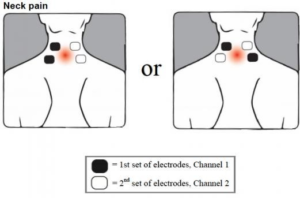Techniques for Managing Neck Pain and Headaches
by Genevieve Jenkins, DPT
AzOPT Buckeye Physical Therapist
Wake up with a kink in your neck? Feeling a little tense in your neck and shoulders after a long day?
You are not alone. Even as physical therapists, we’ve all had our share of neck pain and headaches.
Here are some things you can do to help decrease muscle tension and give your head and neck a little well-deserved TLC:
Take a stretch break
Click here for a detailed description of these stretches
Adjust your work space
Check out this blog for workspace ergonomics.
Ice or Heat
Check out this blog on ice or heat.
Try a TENS Unit
What is a TENS unit?
TENS stands for “Transcutaneous electrical nerve stimulation”
This is usually a small, hand-held unit with wires that connect to patches called electrodes
How does it work?
You place the electrodes on your skin around the area that hurts and the electrical signals act as a distraction for your pain (the buzzing/tingling sensation you feel is sort of like a vibration massage)
Where can I get one?
You can purchase one at most drug stores, as well as Amazon. In some cases, your insurance may cover all or part of the cost (ask your physical therapist how).
Here is a unit we sometimes recommend for our patients whose insurance does not cover a unit, though there are a plethora of options to choose from:
Link for TENS unit recommendation.
General precautions:
Read the instructions carefully and thoroughly before use.
 Ask your doctor before using if you have a pacemaker (could be very dangerous)
Ask your doctor before using if you have a pacemaker (could be very dangerous)
Do not place the electrodes on your temples or on the front of your neck, over your eyes, or around your genitals.
This is a great option to combine with a heating pad or gel ice pack for pain. If you have a TENS unit of your own, you can place the electrodes like so, depending on the mode you’re using (up and down for TENS, criss-crossed for IFC)
Cupping
What is it?
Plastic medical cups placed on the surface of the skin that suction the tissue up to assist with decreasing tension and increasing blood flow.
Cupping has been around for many years and can be used in a variety of ways. In our clinics, we use air only (no fire, no smoke, no puncturing the skin).. Talk to your physical therapist to see if this is a good option for you.
Not getting enough relief? That’s where we come in!
Call us to schedule a free injury screen to determine if physical therapy is right for you!







